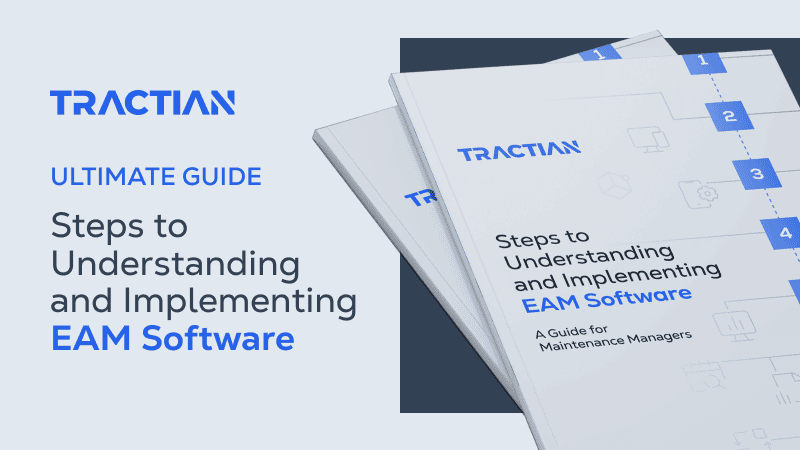For most maintenance teams, completing a work order means fixing the problem, logging a few notes, and moving on. The equipment is back up, the task is marked as done, and production resumes. But what gets overlooked is the opportunity to capture what really happened and why it matters.
Without a consistent approach to work order completion, valuable details are lost: the time it took to respond, which parts were used, what failure patterns are emerging. This doesn't mean just doing the right documentation, but also building a reliable foundation for decision-making.
When those insights are missing, so is the context that helps teams improve schedules, reduce rework, and prevent failures from repeating.
In this guide, we’ll break down what complete work order execution actually looks like, which metrics help measure it effectively, and how maintenance teams can turn everyday tasks into operational intelligence that drives long-term performance.
What Is Work Order Completion
Work order completion is the final stage of the maintenance process, where tasks move from execution to record. It’s the moment when all assigned work is confirmed as finished, documented accurately, and officially closed in the system.
But completion isn’t just a checkbox, it’s the point where maintenance data turns into operational intelligence. When done correctly, it feeds planning, supports compliance, and improves how future tasks are scheduled and executed.
Proper work order completion includes four essential components:
- Documentation: Details what work was done, how long it took, what materials were used, and any changes from the original task plan.
- Verification: Confirms the job was done correctly, often through visual checks, functional testing, or safety inspections.
- Sign-Off: Adds formal approval (typically from a supervisor or quality control lead) ensuring the work meets technical and safety standards.
- Closure: Finalizes the work order in the CMMS, updates asset history, and can trigger follow-up actions like parts restocking or scheduled inspections.
Without proper completion procedures, maintenance teams lose valuable data that could prevent future failures. They struggle to meet regulatory requirements and miss opportunities to optimize their operations based on historical performance patterns.
Why Document The Completion Of Work
Maintenance doesn’t stop at execution, it extends into how that work is recorded, verified, and used to guide what comes next. When documentation is incomplete or inconsistent, the impact compounds over time. What might seem like a skipped field or a missing timestamp can quickly turn into broader operational blind spots.
Without reliable completion data, it becomes harder to track recurring issues, evaluate technician performance, or understand which assets are driving the most downtime. Planning future maintenance becomes guesswork and, even worse, when audits arrive, missing records can mean more than just fines, halting production altogether.
In regulated industries, these gaps carry even more weight. Maintenance records serve as legal proof that safety protocols were followed and standards were met. Without them, even a well-executed job can leave a facility exposed to non-compliance risks.
To put this into perspective, consider a food processing plant that experienced a contamination incident traced to a poorly maintained conveyor. The investigation confirmed that maintenance had been performed, but the completion records were vague and incomplete.
There was no clear indication that the correct cleaning procedures had been followed or that the right replacement parts had been used. That lack of documentation didn’t just slow down the investigation, but it opened the door to regulatory penalties and forced recalls that could have been avoided.
When completion processes are handled correctly, they create the foundation for smarter decisions. They provide:
- Compliance confidence with traceable maintenance logs
- Accurate benchmarks for performance and efficiency
- Historical data to guide preventive planning and resource allocation
- A full asset history to support replacement and warranty strategies
Understanding What a Work Order Really Means
At its core, a work order is a formal directive, it authorizes a maintenance task, outlines what needs to be done, and provides the structure for how that work is executed, tracked, and closed. More than just a form, it acts as a roadmap: defining objectives, assigning responsibility, and ensuring that each job aligns with technical, safety, and operational requirements.
Work orders can take many forms depending on the type of maintenance involved. While each one shares the same foundation, with task details, asset information, and resource planning, their completion expectations differ based on urgency and scope. For example:
- Corrective work orders focus on addressing unplanned failures and usually require fast response and clear documentation of the failure cause.
- Preventive work orders are scheduled tasks based on time or usage triggers, where consistency and proof of completion are essential for audits and planning.
- Inspection work orders are built around verification steps, ensuring safety and compliance checks are completed and recorded properly.
Each type has its own workflow, but they all rely on accurate, end-to-end documentation to drive results. For more details, check out this detailed guide about the different types of work order.
Planning vs. Completion: How Work Orders Flow Through Execution
To manage this process effectively, it's important to distinguish between two key layers of documentation: the work order ticket and the completion record.
The work order ticket is the planning document. It contains the initial instructions: what needs to be done, which tools or parts are required, and what safety precautions apply. It’s how the task is assigned and communicated to the technician.
The completion record, on the other hand, captures what actually happened. It includes notes on time spent, parts consumed, deviations from the plan, and any follow-up actions identified during execution.
In traditional setups, these were separate documents. The technician received the task, performed the work, and then submitted a completion sheet. Today, digital CMMS platforms integrate these elements, allowing technicians to update progress in real time and close out tasks directly from the floor.
Key Steps To Finalize A Work Order Ticket
Closing a work order means creating a reliable, auditable record that connects what was planned with what actually happened. Each step in the process contributes to both immediate execution and long-term maintenance strategy.
Check out the key steps to do that in the best possible way:
1. Prepare the Work Environment and Resources
Before execution begins, the technician must confirm that everything needed for the task is ready, like tools, parts, documentation, and access. Any gaps here often lead to delays, shortcuts, or incomplete records.
Preparation also includes reviewing the original work order details, checking applicable safety protocols, and confirming that verification tools (like test equipment or calibration devices) are on hand.
2. Execute the Task as Specified
Execution should follow the instructions defined in the work order, but that doesn’t mean it will always go as planned. It’s essential that technicians document any deviations, unexpected findings, or additional work that arises during the job.
This phase captures the reality of the task, not just what was supposed to happen, but what actually did. That difference is often where the most valuable operational insights are found.
3. Verify That Work Meets Standards
Once the task is complete, it must be reviewed for quality and safety. Whether through supervisor sign-off, functional testing, or a dedicated inspection step, this verification confirms that the job meets required standards.
Skipping this step can create downstream risk: rework, equipment issues, or safety incidents that could’ve been prevented with a final check.
4. Record Time and Work Details
Precise documentation gives context to the completed work. Start and end times, parts used, meter readings, and technician notes all contribute to a record that’s useful, not just stored.
This data directly influences future task planning, technician performance tracking, and asset reliability analysis. It's also the foundation for understanding workload, cost distribution, and resource efficiency.
5. Close the Work Order in the System
Once verified and documented, the work order is formally closed in the CMMS. This step updates the asset’s history, completes task records, and triggers any necessary follow-ups, such as additional inspections, inventory restocking, or scheduling of related tasks.
It also ensures visibility across the team, notifying planners, supervisors, or operators that the asset is back in service and ready for use.

Metrics That Define Effective Work Order Completion
Tracking work order completion, at the end of the day, is about measuring how well the system supports execution, resource allocation, and long-term reliability. Tractian’s CMMS makes this possible through real-time metrics that go beyond simple completion counts to reveal the actual performance of your maintenance strategy.
Completion Rate
The completion rate shows the percentage of scheduled work orders that are fully executed, verified, and closed within a defined period. With Tractian, this metric updates automatically: only logging a task as “completed” once documentation is finalized and the work is approved.
A consistently low completion rate signals that tasks are being delayed, interrupted, or deprioritized. By monitoring this metric in real time, maintenance managers can quickly identify execution gaps, rebalance workloads, or revise scheduling logic before backlogs spiral out of control.
Time to Close
This metric tracks the average time between work order creation and full closure. It includes execution, documentation, and sign-off steps. A long time to close might indicate supply chain issues, poor planning, or overload on specific technicians.
In Tractian’s platform, you can filter this by asset, technician, shift, or work order type, so you can understand whether your delays come from emergency jobs, PMs, or resource constraints.
Backlog Status
Tractian offers real-time backlog visibility, categorized by status (open, delayed, awaiting parts, in execution). Instead of just showing a number, the dashboard helps you understand why the backlog exists and where the bottlenecks are.
This isn’t just about workload, it’s also a reflection of how well your planning, execution, and resource balancing are working together.
Workload Distribution
Knowing how many work orders were completed doesn’t help unless you know who’s doing the work. Tractian’s technician dashboards show individual workloads, idle time, and execution speed. This helps maintenance managers balance assignments, avoid burnout, and improve labor efficiency across shifts.
Verification and Sign-Off Rate
In regulated industries, it’s not enough to finish a job, it needs to be verified. Tractian tracks the percentage of completed work orders that include formal verification steps like supervisor approval, functional testing, or safety checks. This metric directly supports audit readiness and internal QA programs.
Best Practices for Faster, Smarter Work Order Completion
Optimizing work order completion requires creating a work order system that addresses both process efficiency and data quality. Organizations that excel at completion management focus on removing barriers that slow down technicians while ensuring that documentation requirements support rather than hinder operational effectiveness.
1. Standardize Templates
Standardized completion templates ensure consistent data collection while reducing the time technicians spend figuring out what information to record. Good templates include pre-populated fields for common tasks, dropdown menus for frequently used codes, and clear sections for different types of information.
Effective templates balance comprehensiveness with usability, capturing essential data without overwhelming users with unnecessary fields. They should be designed with input from both technicians who will use them daily and managers who need the resulting data for decision-making.
2. Prioritize Critical Tasks
A clear priority system ensures that the most important work gets completed first, preventing critical equipment failures from being delayed by routine maintenance activities. This system should consider equipment criticality, safety implications, production impact, and regulatory requirements when assigning priority levels.
Priority systems work best when they're simple to understand and consistently applied across all work order types. Complex priority schemes often create confusion and inconsistent application, undermining their effectiveness in guiding resource allocation decisions.
3. Use A Digital Platform
Digital work order systems eliminate many of the inefficiencies associated with paper-based processes, enabling real-time updates, mobile access, and automated workflows that streamline completion procedures. Modern platforms allow technicians to update work orders from anywhere in the facility, reducing administrative time and improving data accuracy.
Modern CMMS solutions allow technicians to document completions in real-time from anywhere in the facility, dramatically reducing administrative time. Streamline work order completion with tools designed specifically for maintenance teams.
Digital platforms also enable automatic notifications, approval workflows, and integration with other business systems, creating a seamless completion process that reduces delays and improves communication across departments.
4. Inspect And Learn From Each Works Order
Completed work orders contain valuable information that can improve future maintenance activities, but this value is only realized when organizations systematically analyze completion data for patterns and improvement opportunities. Regular review of completion records helps identify recurring problems, optimize procedures, and refine resource allocation strategies.
This analysis should examine both successful completions and problematic ones, looking for factors that contribute to efficient work execution versus those that create delays or quality issues. The insights gained from this analysis should be fed back into work order planning and execution procedures, creating a continuous improvement cycle that enhances overall maintenance effectiveness.
How Tractian's CMMS Can Elevate Your Operation
Mastering work order completion transforms maintenance from a reactive cost center into a strategic asset that drives operational reliability and business performance. Organizations that treat completion as a critical process rather than administrative paperwork consistently achieve better equipment uptime, lower maintenance costs, and improved regulatory compliance.
And companies that excel at work order completion typically see measurable improvements in equipment reliability, reduced emergency repairs, and better resource utilization because their maintenance decisions are based on accurate, comprehensive data rather than assumptions or incomplete records.
INPASA is the perfect example, saving over $10 million by implementing digital work order management.
"Tractian isn't simply a sensor provider, it is a business partner who provides availability to our operations," says Itiel Cerkunvis, Inpasa Maintenance Director. The company reduced work order execution time by 25 minutes per order and decreased planning time by 30 minutes daily, contributing to a remarkable 1659.2% ROI after just one year.
But here's the reality: most systems are too complex, too rigid, or too slow to implement. What you gain in theory, you lose in practice, because technicians bypass the system, data goes stale, and leadership stops trusting the numbers.
Tractian's CMMS was built to solve exactly that challenge. From day one, it delivers a platform your team can navigate with ease. Work orders, asset histories, and maintenance schedules are clean, accessible, and mobile-first. It mirrors how maintenance happens, not how software engineers think it should.
It also works offline, so even if your network is down your plant won't be affected. Also, our implementation is free and fast. In a few days your whole maintenance team will begin to see the results.



